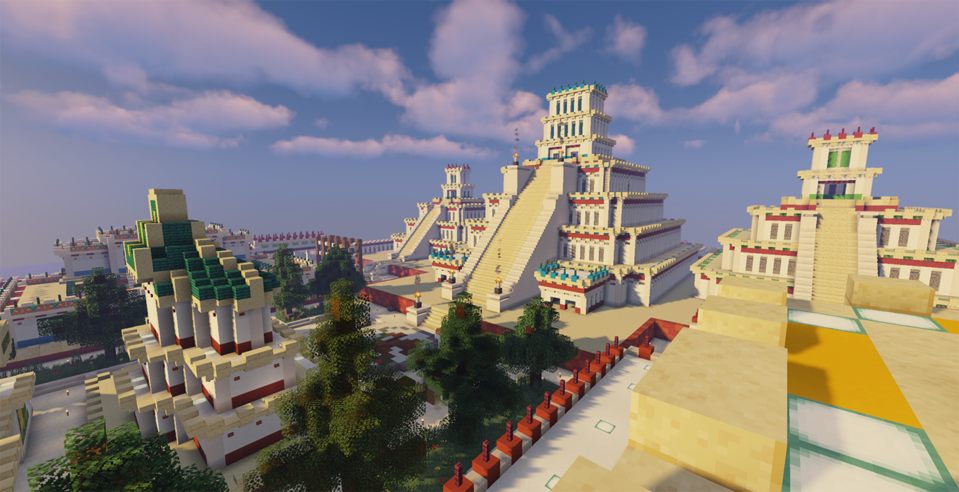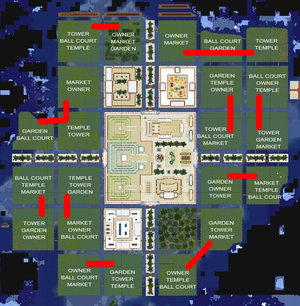Tepēcetlan
Tepēcetlan is a large personal base based on the Aztec capitol city Tenōchtitlan. SeñorKevin, the creator of the city, went to great lengths to replicate elements of the real-world counterpart while still making it distinct. The city is made up of a series of flat islands in an ocean and is surrounded by glaciers. This location gave the city it's name, which translates to "the place among the ice mountains" in the Nahuatl language, the language of the Aztecs.
Throughout the build, there are many canals and elaborate tree-covered walkways used for travel between the several islands. These islands house a large central religious plaza, a king's palace, a market square, a zoo, a botanical garden, farms, and villages. In the plaza and villages especially, there are many intriguing smaller builds, such as temples, skull racks, schoolhouses, ball courts, and more.
| Tepēcetlan | |
|---|---|
| Creator(s) | SeñorKevin |
| Status | Under construction |
| Location | |
| Coordinates | 2870, 3644 |
| World | 1.16 Survival Overworld |
| Nether Path | Blue path, right, quartz pillar and white glazed terracotta. |
| [{{{dynmap}}} Dynmap Link] | |
Early Days and Planning
SeñorKevin wanted to recreate Tenōchtitlan in survival for quite some time, but didn't find a good opportunity to until the 1.16 server update. He quickly began looking around dynamap, trying to find an island or area of ocean suitable for habitation. The island he wanted initially was the one where Birthday Island is currently located, but when asked by WhimsyBridges to relocate, he complied and sailed east until he landed on another suitable island.
At this time, the island was covered in spruce forest and mountains. SeñorKevin decided he needed to flatten the large island before constructing the city, reasoning that the large landmass would help him scale the city properly and assist with planning. This was a questionable decision; the excavation process took months to complete.
With a completely flat landmass, planning for the city could begin. The city was to be laid out in a cross shape, with paths running north-south and east-west, dividing the city into four corners. These paths would lead to a central religious plaza. Then, all four corners would be divided into smaller islands, with some housing important government and societal buildings/locations and others housing villages where civilians would live.
Several prominent buildings within Tenochtitlan would have to be recreated or approximated within the city. These included prominent temples in the religious plaza, the king's palace, at least one botanical garden, a zoo, and a market square. These were placed directly next to the main plaza, either to the north or south, with the reasoning being that such important buildings should face east or west so they may see the sun and moon. However, there was still the issues of the villages.
The villages were to be broken up into smaller districts, each of which would contain many smaller elements that would be required for governance and decent quality of life for the residents. These included homes, "towers" (poles on which the Danza de los Voladores could be performed), owner/governor's palace, small markets, small public gardens, ball courts (on which Mesoamerican Ball Game could be played), small temples for worship, and schoolhouses.
Notable Locations
Tepēcetlan contains a number of important and distinct islands/locations:
Religious Plaza
Located in the center of the city, the religious plaza contains religious temples. At time of writing, there are temples dedicated to Tlaloc, Quetzalcoatl, Huehuecoyotl, Xolotl, Tezcatlipoca, Opochtli, Yacatecuhtli, and Mictlantecutli. There are also temples without an associated god.
Some temples serve double duty as places of worship and as some other important societal building. Quetzalcoatl 's temple is a bathhouse, Tezcatlipoca's temple is a schoolhouse, Yacatecuhtli's temple has a nether portal, and Xolotl's temple houses God - a pink axolotl.
There are a few other buildings and notable features in the plaza.
- There is a large disk on the ground near Yacatecuhtli's temple with the image of an eagle atop a nopal cactus eating a snake. This a reference to the Aztec story of the founding of Tenōchtitlan; the Aztecs traveled far south into central Mexico and saw this event taking place on an island in Lake Texcoco (currently Mexico City.) They believed this was a sign from the gods and that this was the place where they must construct their empire.
- There is a small ball court. This court is modeled after those used in Mesoamerican Ball game, a game similar to soccer, basketball, and volleyball.
- There is a skull rack containing the heads of several mobs and animals. This is a reference to the skull racks prominently displayed in Tenōchtitlan, which were likely used to scare political enemies and potential criminals.
Construction, Materials, and Assistance
Construction of Tepēcetlan has been going on since the first month of the 1.16 survival server, whether it be flattening the island, digging canals, or constructing buildings. Although construction is ongoing, many of the most important structures have been completed, with only the villages and outer farms needing to be completed.
Most of the societally important buildings are made of mixes of snow, smooth quartz, terracotta/concrete, and sandstone of several varieties. The amount of quartz used in Tepēcetlan is often a source of awe for visitors, as is the use of bone blocks in the ground of the plaza and the main walkways.
Villages are mostly made of several wood and terracotta varieties, reflecting the materials that Aztec commoners had access to. However, some buildings reflect the opulence of the societally important structures. For instance, the homes of the owners/governor's of each district are effectively small versions of the king's palace. They are made of quartz, snow, sandstone, and terracotta/concrete.
Although all construction was done by SeñorKevin, material donations from the community have been and continue to be frequent. Notable contributors are Orca_Bird (sandstone), LonkReborn (quartz), and G0rd0nFreeman (quartz).


